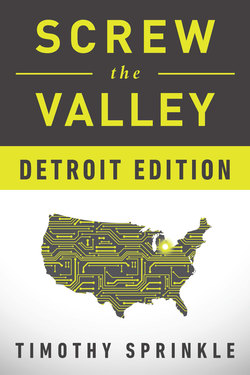Читать книгу Screw the Valley: Detroit Edition - Timothy Sprinkle - Страница 5
На сайте Литреса книга снята с продажи.
ОглавлениеIntroduction
IT HAS been a rough couple of decades for the Detroit metro area.
The once fastest growing, most dynamic city in the United States saw its fortunes fade alongside those of the American auto industry in the 1990s and early 2000s. Iconic corporations declared bankruptcy, thousands of jobs were lost, and residents began fleeing greater Detroit in droves. The city’s population peaked in 1950 at more than 1.8 million. By 2013, that number stood at roughly 701,000, a 61 percent drop. Just since 2000, the population of Detroit’s 142 square miles has fallen by 26 percent.
And that’s just the beginning of the story.
Without a sufficient tax base in place, city services like fire and police protection have suffered in recent years, leading to an entrenched culture of violence as well as earning Detroit a reputation as one of America’s most dangerous cities. Streetlights burn out and are never replaced, potholes go unrepaired for months, and aging infrastructure is visible everywhere from rusty downtown bridges to the city’s shaky power grid, which contributed to widespread blackouts in 2014. Suburban flight and plummeting home values have left as many as 78,000 abandoned structures in the city, all of which are now prime targets for arsonists, leaving everything from single-family homes, former apartment blocks, commercial structures, and even public buildings in a landscape of urban decay.
Detroit’s long decline hit bottom in 2013, when the city filed for what remains the largest municipal bankruptcy in U.S. history, with estimated debts of more than $18 billion. According to the filing, the debt load included $3.5 billion in underfunded pension liabilities, $6.4 billion in obligations backed by enterprise revenue, roughly $6 billion in health care costs for retired workers, and more than $1.4 billion in pension-related bonds that the city had been using to support retirees when it couldn’t pay its bills, among many other creditors. The Detroit Institute of Arts even considered selling its collection of masterpieces—which includes pieces from Diego Rivera, Mary Cassatt, Winslow Homer, John Singer Sargent, and many more and valued at more than $8 billion in total—to help pay the city’s massive debts. Fortunately for Detroit and its residents, an emergency manager was brought in by the state. The debt was restructured and the city successfully exited bankruptcy in December 2014.
Still, in the face of all this bad news, there is optimism in Detroit. You can see it in the Ferndale neighborhood north of downtown, where dozens of small business owners have set up shop and serve a lively daytime crowd. You can see it on the campus of Wayne State University, mere blocks away from so much blight, but also home to some of the city’s most active business incubation centers. And you can see it in the urban core, where developers have taken advantage of record-low real estate prices and begun renovating office space and residences for a new generation of downtown Michiganders. Most of all, though, you can see it in the faces of the people who are coming into downtown Detroit specifically to start businesses there.
“Detroit isn’t what it was twenty years ago,” Greg Schwartz, the co-founder of calendar app UpTo told me in 2013 when I was in the city researching my book, Screw the Valley: A Coast-to-Coast Tour of America’s New Tech Startup Culture. “Now restaurants are opening up. Part of it is how much has come up in the past twelve to eighteen months. The thing that really blows me away is not just working down here but living down here. A large chunk of [employees in] this building lives around here and hangs out all the time in Downtown Detroit. And that was never the case growing up. It’s cool to be in Detroit. It used to be cool in the suburbs, but now there are cool restaurants, cool bars down here. It’s the thing to do. A really cool sort of cultural shift has sort of happened.”
